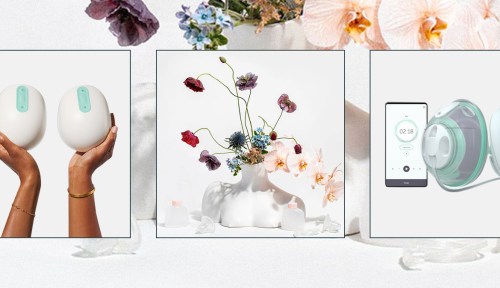Our editors independently select these products. Making a purchase through our links may earn Well+Good a commission
When Laurie Skurow began using her breast pump in 2014, she had plenty of reasons to hate it. There were the typical inconveniences: “I was commuting to work on the train, so I had to schlep my massive pump and all the parts downtown,” the Chicago-based HR consultant says. And there were the equally typical humiliations to consider, too: Because her office didn’t have a lactation room at the time (Illinois law didn’t specify that employers must provide this until 2015), the new mom had to pump in a storage closet with spotty Wi-Fi and no lock on the door. “Someone walked in, and I was just sitting there, topless, with these plastic funnel things attached to me, hanging off my breasts… it was incredibly embarrassing.”
Experts in This Article
CEO of Willow Innovations
Samantha Rudolph is the co-founder and CEO of Babyation, a venture-backed startup that is unapologetically for moms. Babyation creates products for women that want to parent on their terms, beginning with an innovative breast pump that is quiet, discreet and smart.
Pumping while working required she stop what she was doing two to three times a day for at least 30 minutes at a time, and she quickly deemed that too impractical and often demoralizing to continue. “You had to be so committed, and you had to be willing to put up with so much, and I couldn’t do it,” Skurow says. “My milk dried up.”
It was because of the breast pump (and, of course, a lack of supportive employer and community resources) that led her to end her breastfeeding journey earlier than she had hoped, four months after it began.
Also in 2014, Samantha Rudolph, who would eventually become a leading innovator in the breast-pumping space, was discovering the unfortunately commonplace nature of experiences like Skurow’s. Rudolph wasn’t a parent at the time—she didn’t even know anyone personally who had a baby. But, she’d come across a New York Times article posing the question of why people who breastfeed “had been duped into settling” for the breast pumps available at the time. Mobile phones had advanced from clunky hunks of plastic and wiring into sleek iPhones you could slip into your back pocket, and hybrid cars were being manufactured to make less noise than the “HEEE HAWWRRR, HEEE HAWWWRRR” of a standard pump. The same, steadied innovation could simply not be said for the breast pump.
The first breast pump was patented in 1854 by inventor Orwell H. Needham, which was essentially a human version of a cow-milking machine. It used a cone-shaped rubber cup, a pump squeezed by hand, and a flexible tube to carry the milk to a bellows fitted into a box. When electric pumps became available at hospitals in the early 1980s, the schematics weren’t all that different from those drawn up more than 100 prior. By 1991, Swiss manufacturer Medela introduced the first electric pump for home use, and it’s more or less what breastfeeding parents have been saddling up to use ever since. It’s what Skurow used with both her babies, and what she still remembers made her feel “like a cow” just eight years ago.
That so little innovation had taken space in such an integral market “felt inexcusable” to Rudolph, who remembers thinking, The technology is there—it has been there. So what is going on?
She had a pretty good idea, and it was in alignment with the ethos of “If Men Could Menstruate,” an article by feminist journalist Gloria Steinem published in Ms. magazine back in 1978, satirizing the gendered treatment of basic human needs—and its points still largely true. “There’s this hierarchy—there’s men, then there’s women, then there’s moms,” Rudolph says. “There’s been more innovation in farming, with no disrespect to that industry or to animals…but the dairy cows don’t put up with what we put up with.”
“I said to myself, ‘It doesn’t have to be this hard.’ There could be solutions, but it starts with the belief that moms deserve a better world, and that it is possible to create.” —Laura Chambers, Willow CEO
Upon becoming a mom for the first time more than 10 years ago, Laura Chambers, who would go on to become the CEO of wearable breast pump company Willow, had a similar realization—and decided to do something about it. “I thought, Wow, this is really hard. The narrative is: ‘Of course it is. Motherhood is hard, it’s been hard for generations,’” she says. “But I’m a problem-solver. I said to myself, ‘You know, it doesn’t have to be this hard.’ There could be solutions to some of this. But you have to start with the belief that moms deserve a better world, and that it is possible to create.”
The breast pump glow up
That creation phase is exactly what happened in the next few years, and breastfeeding and chestfeeding parents are still reaping the benefits: As Willow was in development with the first-ever all-in-one wearable pump, which was first released in 2017, Rudolph was working on an app-controlled pumping solution that would disconnect a nursing parent from an outlet. It had to be quiet and, ideally, undetectable. Ultimately, Rudolph formed the company Babyation, and in April, launched “the world’s most discreet breast pump” simply called the Pump ($499), to a 4,500-person waiting list.
While Willow caters to folks seeking mobility, Babyation Pump capitalizes on the fact that it’s not a wearable pump at all. “A wearable puts everything on the breast, and for a lot of women, it doesn’t solve the inherent problems of an indiscreet pumping experience,” Rudolph says. “You can tell when someone is wearing them. And if I’m craning my neck to see how much milk is expressed, or if I’m trying to troubleshoot the pump under my bra, that’s not discreet.” Instead, the Babyation Pump minimizes what’s on the body—just two, ultra-small breast shields underneath clothing and an inconspicuous tube that runs into an all-in-one storage bag at one’s side.
Happily, the Pump is the latest in a recent flurry of new developments to the breast pump. Along with the Willow ($500)—the first mobile pump that cut out the cords and dangling bottles and fit inside a bra—there’s the Elvie Pump, $550, another wearable that bills itself as the first “silent” pump, which came out in 2018. Also in 2018, the same engineers who took part in one of MIT’s two “Make the Breast Pump Not Suck” hackathons released the patent-pending Pump2Baby Bottle, a novel breast pumping accessory that allows for pumping directly to a baby.
Like with many first-to-market offerings, these initial 2.0 versions of the standard pump had their kinks to work out. Fast-forward a few years, and, thankfully, the innovations continue.
Willow, for one, is now in its third generation, the Willow 3.0. Following ongoing clinical trials and consistent feedback from both user surveys and its customer-care team about frustrations including limited sizing options, pain caused by the pump’s constant suction, and sticker shock over the added costs of its proprietary, non-reusable bags, the company has made a number of design changes since its launch. This includes editing the shape of the flanges for better visibility, adding more sizing inserts, offering the option to purchase reusable milk containers, and making its pumping sensation “wave form” to provide a more comfortable latch while maintaining high milk output.
People who pump are “different with different priorities and constraints. We don’t want the pump that forces us into a coat closet with our shirt off.” —Samantha Rudolph, CEO and Cofounder of Babyation
Clearly, there’s yet to be a single pump on the market that serves the needs of all breastfeeding folks. Having the option of an all-in-one wearable system might work better for someone desiring portability, like “a mom chasing after toddlers at home or a paramedic doing CPR compressions,” Chambers says, whereas those with long commutes or an open-floor plan desk job might prefer one that provides more privacy but doesn’t require 360-degree mobility. Ultimately, people who pump are “different with different priorities and constraints,” Rudolph says. “Bottom line: We don’t want the pump that forces us into a coat closet with our shirt off.”
Of course, there’s also the ongoing matter of the cost: Parents can’t feed a baby using a pump they can’t afford to buy. Again, Willow 3.0, Elvie, and the Babyation Pump all hover around the $500 mark, not including a number of accessories, like bags and tubes, required for continued use.
Under the Affordable Care Act, breast pumps are required to be reimbursed by insurance companies, but there’s no regulation around the type of pump that’s covered. Because of that nuance, reimbursements on these next-generation pumps vary—Willow states that its buyers, on average, receive a return of $95 to $160—but they usually still come with sizable out-of-pocket costs.
Working toward greater accessibility, Willow unveiled Willow Go—a more affordable all-in-one wearable pump model—in March. It doesn’t offer the full range of motion of the Willow 3.0, which lets you pump while bending completely over or lying down, but if a completely in-bra design and hands-free pumping is the goal, it’s a deal: the Go costs $330, or as low as $150 with most insurance plans, according to Chambers. “It’s within the realm of affordability, particularly if it’s the thing that unlocks your ability to go back to work,” she says.
The Elvie also now offers a Stride Plus, a $350 version of its wearable pump that includes cords connected to a separate hospital-grade motor, which is small enough to be hung around one’s neck or clipped on to pants. It also offers the Elvie Curve, a manual in-bra silicone pump, for $50, and the Elvie Catch, $35 milk collection cups. These accessories, while not meant to replace a pump, offer breastfeeding parents more autonomy from their pumps, wearable or otherwise. If a breastfeeder doesn’t want to don their Willow or Elvie pump during a work event, for instance, they can prevent leakage—and still collect every last drop of milk—with the Elvie Catch.
What’s next in the landscape of breast pump innovation?
Both Rudolph and Chambers say their companies have no plans to stop disrupting the pumping industry or lobbying for ways to ensure their products are as financially accessible as older-school models that have long cornered the insurance-paid market for pumps for decades.
Chambers confirms that the Willow Go is the first milestone in a multi-year product-release strategy, and is confident that with each new problem solved, we’ll begin to consider Skurow’s pumping journey—the under-supported one to which so many breastfeeding parents can still relate—what it truly was: barbaric.
“We’re creating real change, being able to untether moms and give them more freedom and flexibility,” says Chambers. “We’ll be looking back in a decade, and we’ll be astounded that people ever plugged into a wall. It’ll be one of those things like, ‘You lived before cell phones? You actually used a traditional pump?!?’”
Oh hi! You look like someone who loves free workouts, discounts for cutting-edge wellness brands, and exclusive Well+Good content. Sign up for Well+, our online community of wellness insiders, and unlock your rewards instantly.
Sign Up for Our Daily Newsletter
Get all the latest in wellness, trends, food, fitness, beauty, and more delivered right to your inbox.
Got it, you've been added to our email list.











